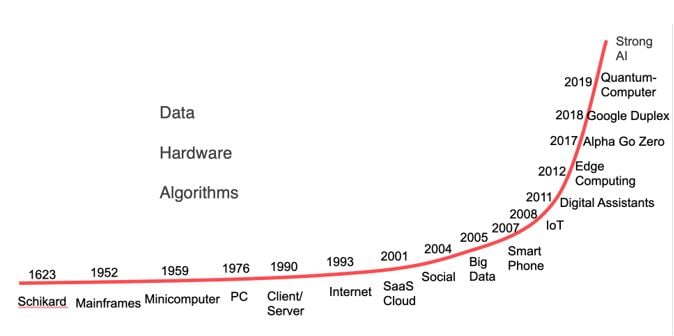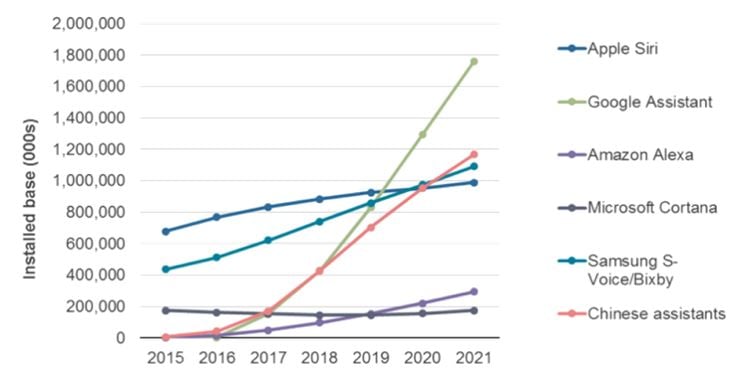Modern customer relationship management, if I may use this ancient term, is undergoing significant change. It is a change towards achieving customer outcomes. But then, whether we call it Customer Relationship Management, Customer Engagement Management, or Customer Experience Management does hardly matter. What does matter is the profound impact for your business (as well as Enterprise Software vendors) that this change has.
Trends, trends, trends
The change is driven by a number of trends:
- Quickly increasing computing power
- Cloud and SaaS as delivery models
- Mobile and social
- Vastly improving algorithms
- A rebirth of AI and machine learning as a consequence
- Quite some ingenuity in creating solutions that are valuable for customer
- And, most importantly, rising customer expectations
I do not need to say much about increasing computing power. We all know about Moore’s law that, in spite of being pronounced getting invalidated, still holds true. And upcoming quantum computers should give it yet another boost.
Cloud and SaaS as delivery models have enabled unprecedented scaling of applications while drastically simplifying their delivery to customers as well as the management of upgrades. On top of that, they enabled pay-per-use business models.
Mobile and social have drastically changed the information balance. Before the smartphone became ubiquitous, which caused a skyrocketing of social networking, customers needed to rely upon what information they got served by businesses. If you follow the Edelman Trust Barometer, you can still see that there is quite some distrust in company communications, albeit slightly rebounding. Still, slogans like SAP’s (borrowed from Forrester) ‘The Age of the Customer’ or Microsoft and Nimble claiming the customer being in control, clearly show that there is a growing understanding that ways have changed. Although the days of saying that customers only trust ‘a company like me’ are past, we clearly live in times where customers have plenty possibility to get more or less independent information about products, services, vendors.

Algorithms improved during the past two decades, too. However, earlier they could hardly be implemented, lacking the compute power. For example, implementing deep neural networks, and the learning algorithms that make them usable, need immense computing power. Or think of image recognition. When we implemented early trials of road sign recognition at my university, the necessary computers needed the complete trunk of the car (which better was a station wagon). Additionally, the car needed to stay below 30 km/h for the processing being fast enough. This wasn’t a software limitation, but a hardware one.
All gone. Today we do see AI doing speech recognition that is better than that of humans. As examples, Microsoft reported a word error rate of 5.1% in 2017, and last year an Alibaba AI topped humans in reading comprehension.
Image recognition shows a similar trajectory. We have seen a 97% top five classification success in 2017, and in 2018 a Facebook trained AI achieved an 85% top one classification success on ImageNet.
Both, the increased computing power and availability of powerful algorithms, combined with the availability of lots of data, are main parts of what I would call the rebirth of AI and machine learning. There is virtually no business application that does not tout AI and M/L capabilities of one sort or another anymore.
It didn’t stay there. Technologies that are developed for their own sake stay just that – technologies. It is their meaningful application towards an end, that makes them useful. While the use of modern technology still is a sales argument, technology more and more becomes the enabler of solutions, in the case of AI and M/L of solutions that often haven’t been possible to implement. Again, think speech recognition, face and image recognition, or all sorts of pattern recognition in massive data.
The Master Trend
In the CRM/CEM/CEX world, however, all these are meaningless without the most important one, the one they all serve:
The customer expectations are rising. Customers want (and deserve) their needs fulfilled with minimal own effort. After all, they are the ones who foot the bill by buying the products and services that they want and need.
The customer journey has evolved, become more individual, and that forces businesses to alter the way we interact with customers.
We need to be sure that we identify their intents early and correctly. Then we need to supply them with exactly the relevant answer on exactly the channel they want to receive it. Basically, this means that not businesses are defining the customer journey but the customers themselves define their individual journey.
This also means that there is an increased need for recombining pieces of information into a meaningful, individual whole, instead of having ‘one sizes fits all’ prebuilt information packs.
And a text or even voice interface increasingly becomes the ‘channel’ of choice. After all, text and voice are the communication interfaces that are most natural for us.
At this intersection of computing power, algorithms, data, and customer expectations lies a tremendous opportunity.
It is where AI, M/L, in combination with bots, come into the picture to help put the customer at the center of thinking as they are gaining customer’s acceptance fast.

I rarely see my kids on e-mail. What they do is messaging, by text and by voice. They communicate via voice messages on messaging services and they use Siri or Google Assistant to search.
Even we, as an older and generally more conservative generation are turning to voice. How do you interact with your car’s systems? Phone, navigation, radio, … I increasingly use voice, which works amazingly well.
That’s why it is important for businesses to concentrate on AI-driven bots.
What it means
Businesses must not miss these trends. Instead, they must have a look at where they can serve their customers better or where they can mitigate an internal pain point and improve or automate processes using AI driven bots. It is something that needs to be identified on business-individual level whether to start customer- or employee facing.
It doesn’t really matter whether the journey to adopting AI-driven bots starts with an internal facing bot or with a customer facing one. What does matter is that the initial implementation creates value and that it is a viable implementation that solves an actual problem? In the best sense of a minimum viable product, the problem that is addressed can be relatively small but it needs to be solved well. This solution includes a properly planned and executed handover to a human operator where the AI-driven bot reaches its limits.
But the start of the endeavor is a detailed analysis of the problems at hand and what the customers actually want – and what they do not want. Based on this analysis, choose a pressing issue that does not have too high complexity
This way the customers, internal or external, feel engaged in a positive way. At the same time, the business gains experience in implementing a successful bot without extending itself too much. Based upon the success and learning of this project extend its reach into solving additional challenges with the help of AI-driven bots.
This is another implementation of my think big – act small philosophy; and there is no other way of meaningfully create bot engagements that result in positive customer experiences.



